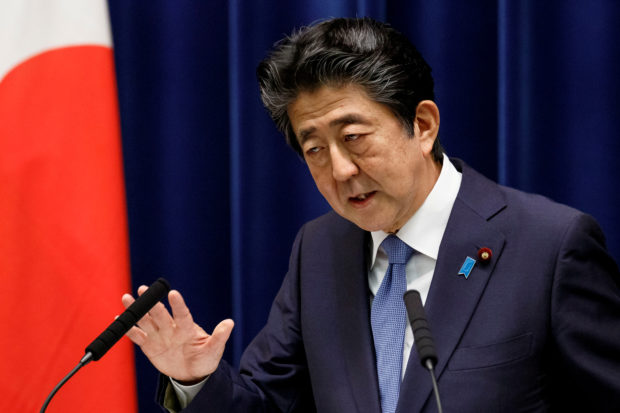The long shadow of Abe’s political legacy

Japanese Prime Minister Shinzo Abe speaks at a news conference at the prime minister’s official residence in Tokyo, Japan June 18, 2020. REUTERS FILE PHOTO
TOKYO — Shinzo Abe was Japan’s longest-serving prime minister but his influence stretched beyond longevity, with his policy priorities likely to cast a long shadow over his successors.
Here are some of the assassinated former leader’s key political legacies:
Abenomics
Abe began his second stint in power in 2012 by launching an economic revitalization strategy that bore his name.
It pushed monetary easing to stimulate inflation, massive government spending, and structural reforms, particularly on lifelong employment.
A decade later, the Bank of Japan has held fast even as other central banks tighten, although it faces increasing pressure as prices rise and the yen weakens.
Article continues after this advertisementThe government has also spent big on pandemic stimulus, and Prime Minister Fumio Kishida has urged businesses to raise wages.
Article continues after this advertisementWhile Abenomics has often been praised, the results have been uneven, with inflation proving elusive and wages stagnant.
Share prices soared, but so did income disparity, and Kishida has pledged a “new capitalism” to address inequality, though with few details.
“I think Abenomics is still alive in the sense that that’s how the (ruling) Liberal Democratic Party does the economy,” said Paul Nadeau, adjunct professor of political science at Temple University’s Japan campus.
Engaging with the world
Abe made foreign policy a priority, nurturing personal ties with international leaders.
“He put Japan back on the world stage and he was really driven by that,” Nancy Snow, an expert on international relations and former Abe fellow, told AFP.
“He went on record and said, we’re not going to be a tier-two country.”
Abe famously moved fast to secure close relations with then-US president Donald Trump, becoming the first foreign leader to visit him post-election.
The charm offensive appeared to pay off, with Japan avoiding a hike in payments for hosting US troops and feared tariffs on vehicles.
Abe also led Japan into a key regional trade deal and strengthened ties with India, helping revive the Quad grouping seen as an increasingly important counterweight to China.
Defense, constitutional revision
Abe made no secret of his desire to reshape Japan’s defence policy, including by reforming the post-war constitution to recognise the country’s armed forces.
“He wanted to beef up the military and that wasn’t just because of China,” said Snow.
“That also had to do with how he measured power in international relations: the tier-one countries are the ones that have a strong military.”
His government reinterpreted the constitution to allow Japan to come to the aid of an ally, but he failed to win support for reforming article nine — under which Japan renounces war and pledges not to maintain a “war potential”.
The issue remains on the table though, with Kishida promising new discussions this year, as Russia’s invasion of Ukraine and Chinese sabre-rattling over Taiwan sharpen domestic opinion on defence needs.
“Kishida’s a pretty neutral character, he’s certainly not a hawk,” said Nadeau.
“So I think when he talks about increasing defense spending and maybe constitutional revision… the public is a little bit more reassured that he’s not going to go too far.”
Scandals
Abe stepped down for health reasons in 2020, but his tenure was not without scandals.
They included controversy over his 2013 visit to Yasukuni shrine — which venerates Japan’s war dead, including some convicted of war crimes — and revisionist views on the country’s wartime actions.
His positions on a range of policies were not always popular, and he faced large public demonstrations of the kind rarely seen in Japan.
He was also embroiled in a series of cronyism scandals, including over the cut-price 2016 sale of state-owned land to a nationalist school operator with ties to Abe’s wife.
“To me personally, that cronyism, the friends first, that was one of Abe’s biggest failings,” Nadeau told AFP. “That’s part of his legacy too.”
RELATED STORIES
Japan bids somber farewell to slain Shinzo Abe, its longest-serving premier
The DIY gun used to kill Japan’s Abe was simple to make, analysts say